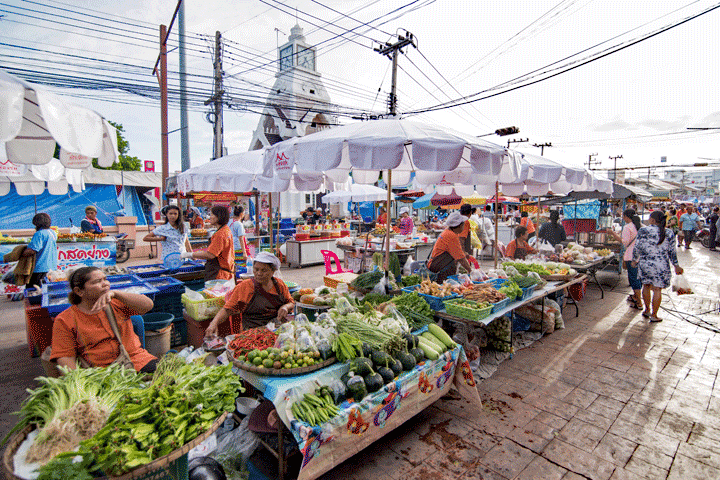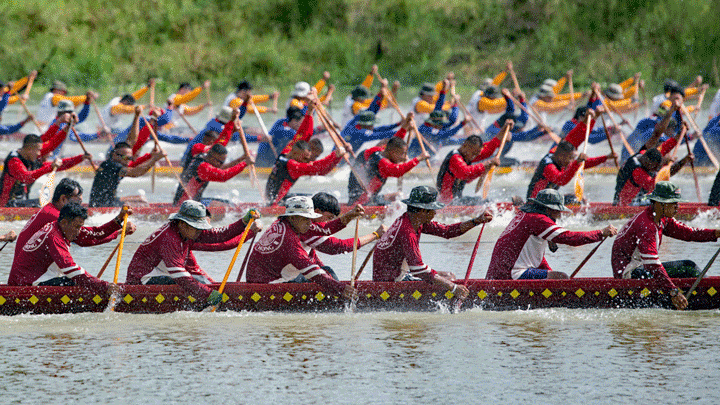
Phimai Festival in the Town (amnat30 / Shutterstock.com)
If you are on Highway No. 2 to the north, about 20 kilometers after Nakhon Ratchasima you will see the turn off road number 206, which leads to the town of Phimai. The main reason to drive to this town is to visit the "Phimai Historical Park", a complex with ruins of historical Khmer temples.
If you type Phimai in the search box, you will see a number of articles by fellow blog writer Lung Jan, which provide detailed explanations of the temples and ancient city walls.
I have been there many years ago while traveling through the Isaan with friends and visited the park. That was, to be honest, not really a success. With the knowledge from Lung Jan's stories it would have been much better, but ruins don't mean much to me. I am more interested in the people who have lived there, I like historical stories about people and not so much the remains of buildings. Both times we were there, we had seen the park after an hour. It was still too early for lunch, so back to highway Nr. 2 and on to the next destination.
Many visitors to the historical park, perhaps more interested than we were, leave Phimai without paying any attention to the town itself. That is a pity and the same observation was made by Rungsima Kullapat, head of a research team at the Rajamangala University of Technology Isan in Nakhon Ratchasima, who set up the Phimai Heritage Project. “There is so much to see in Phimai beyond the historical park”. he says.
The idea for this project was born from the idea that the historical temple complex was given all the attention in its development as a tourist destination while forgetting about local life and history. The historic park is visited by tens of thousands of people every year, but only a few stay a little longer or spend the night in one of the local hotels.

Longboat Race at the Khlong Chakarai River in the Town of Phimai (amnat30 / Shutterstock.com)
In an article on the PBS World website, Rungsima says he is convinced that local activities and products can attract more Thai and foreign visitors. He cites as an example the Phimai noodles that are made manually from rice only, the “rua i-pong”, a canoe made from a hollowed-out palm tree, which is still used as a local means of transport. The people of Phimai are now encouraged to develop more tourist attractions, such as guided tours and culinary workshops.
Read the whole article, supported with photos at this link: www.thaipbsworld.com/putting-old-town-phimai-back-on-the-map


Hi Gringo,
Are you sure about that exit to 206 20 miles north of Korat? I think it is around 50 km from Korat to the turn off to Phimai. Route often driven viz.
I haven't measured it, you're probably right.
Thanks for the rectification!
And while you're in Phimai, don't forget to visit the recently renovated National Museum. There you can also learn something about the former residents and local history. Recommended.
I often take the road to KHON KAEN from Korst, and see that the exit to Pimai on road No. 2 is 60 km from Korst and that you have to do an extra 10 km after the exit to get to the center of Pimai. My last visit was in February 2020 and I noticed that the historical museum has made many positive adjustments for tourists. For example, the walking paths have been renewed and the entrances of the reunion have been made more accessible by making normal stairs.
What strikes me about Pimai is that people rarely talk about the mangrove 2 km outside the center. Where you can walk between the tree roots and along a beautiful pond to a footbridge, ideal place for taking pictures. Feeding the fishing is also a pleasant thing for children. You can eat yourself on the other side of the street in the large open-air restaurant Only Thai food.
That's right Lungfons
I was there for the first time in 1986 and it is the largest Banyan tree in Thailand over 1350m2 and was (are) often compared to what they call the ficus in NL and is often worshiped and decorated with ribbons as is often the case with trees .
Indeed worth it. We were there in 2015 and were lucky that there was a dance and light performance in the temple complex just that evening. (Start: 20:00. We were there a quarter past and were the first :-). Around 21:00 it really started.) Phimai was on our list of possible places to live, but in the end it didn't happen. Photos of the temple-at-night and Thailand's largest banjan tree http://www.flickr.com/photos/miquefrancois/albums/72157720189357238.
Phimai Histrorical Park is definitely worth it.
Real archaeologists will undoubtedly be able to walk around for days, we would have seen it ourselves after 1,5 hours. Nice to sit in the shade under one of the trees, away from the heat.
Good to combine with a visit to Korat Zoo.
Entrance to the complex is very affordable (from memory 50 baht adults (both Thai and Farang!) and 20 baht for children
I lived there with a girlfriend for several seasons.
Nice town to retire. Good introduction to Thailand.
Little happens. The residents pride themselves on the fact that there is not a single bar (red bar). Rightly so.
You don't have to go to Phimai for that.
They also pride themselves on the fact that no one goes 'wrong', ie all residents have an honorable (important or unimportant) profession.
No one is in a dishonorable situation.
The town organizes many activities, there is regularly a festival.
For example, there are the famous rowing boat races in the autumn.
The historical park is the jewel in the crown.
Don't forget it's not Thai own heritage. The temple complex belongs to the Khmer, civilization that arose as early as the 2nd century AD, which occupied a large part of Thailand when there were no Thai people. That only arrived after 1000 via Yunnan, China in what is now called Thailand!
So it is also an ambiguous fact for the Thai.
It is somewhat comparable to our regions in the Roman Empire.
We are also not going to declare the Romans as our national ancestors. They were occupiers.
But the Thai respect their foreign heritage from a distance and take care of it.
There are plans to expropriate everyone in the historical part, so that it is only a historical site. That would be revolutionary.